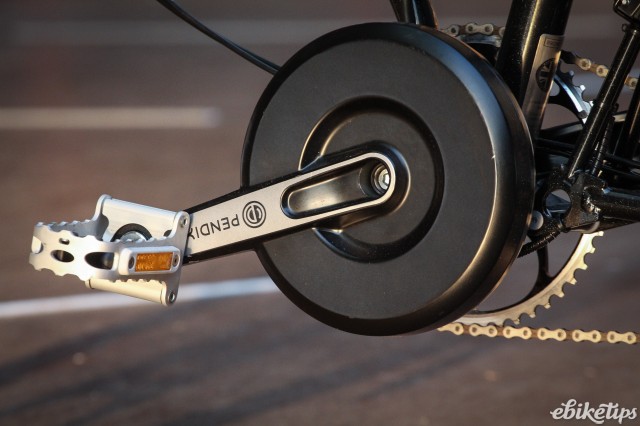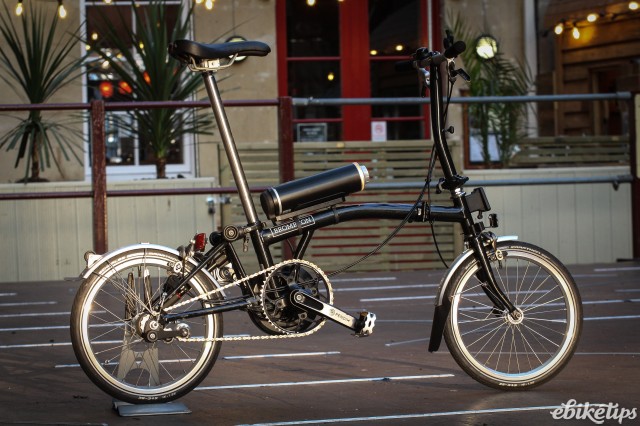Pendix e-bike system

Overview
- Beautifully made
- Neat and east to fit
- Reasonably light, weight is central
- A bit lacking on power
- Power delivery can be choppy
- Range is average
The Pendix system is certainly an interesting one: it looks classy and it's retrofittable to pretty much anything. It works too, though it's more of a gentle shove than a full-on hill-conqueror. The power application takes a bit of getting used to, and it's pretty expensive for what you get. As a way of adding power to an existing bike it's neat and simple, but you can get more from your money by spending it in other ways.
We had a look at the Pendix system when it arrived in the office attached to a Brompton, and made a video. Here it is:
Essentially the Pendix system is a motor/chainset unit and a battery. You take off your existing chainset and fit the motor and a matching chainset that's part of the kit; The motor pushes the non-drive-side pedal out so Pendix give you a similarly widened chainset to even things out. The battery mount can be attached to a bottle mount, or zip-tied to the frame. The battery slips into the mount and clicks into place; when it needs recharging you remove it (it's not locked on) and sit it in a rather nice brushed aluminium charging station. The Pendix system uses the magnetic EnergyBus connector standard that Brose, among others, also employ.
It sounds easy to fit but Pendix only allow fitting at an approved dealer, so you can't do it in your garage. Once you have it installed the controls are simple and minimal. There's a power button on the battery, and a rotary switch on the top of the battery that allows you to swap between the Eco, Smart and Sport modes. A ring of LEDs below that give you a battery level indication. 100% is green, then you go through yellow (70%) and orange (40%) before red (10%) gets the alarm bells really ringing. It takes about three hours to recharge the 300Wh battery; a 500Wh unit (longer but the same diameter) is also available. You can get a two-battery kit too, with any combination of batteries you like. Those, obviously, are more expensive.
The chainset motor has a maximum stated torque of 50Nm. That's similar to a Bosch Active Line or Shimano STEPS city mid motor, or a higher-spec hub motor. In reality it doesn't feel as powerful as that. The Eco mode really is a very gentle assistance, with the Smart and Sport modes increasing the help on offer, but you never get near what you'd get from a decent hub motor bike, never mind a mid-motor setup. On my benchmark climb home (1.5km at 5%, 12% maximum) the Pendix was pretty hard work on the steeper bits. Well, relatively speaking.
Part of that is down to the way that the Pendix applies power. You have to be quite smooth with your pedal stroke to get the best out of it: if you ease off in the dead spots of your pedal stroke then you get quite a choppy response as the motor comes in and out. For the same reason, it's not really very good if you stand up on the pedals. On the flat it's a much more accomplished system, giving you a decent amount of help to keep you fresh on your commute. Overall though, it's not “An eBike with the most natural pedaling sensation in the world”, as Pendix claim. The central position of the system weight (6.7kg) means that the handling of the bike isn't really affected at all.
For the 300Wh battery Pendix claim a maximum range (in Eco mode) of 100km, which I'm going to suggest is pretty fanciful. Realistically the flatland range of the Pendix is more like half that, and once you start adding in hills that comes down pretty steeply. It'll depend on where you live, how you ride and what you weigh, as always, but this is a short-hop system that you'll need to charge regularly. That's fine for the sort of mixed mode commuting you'd be doing if you had it fitted to a folding bike, like we had, and removing the battery for charging is simple.
All in all it's a decent system but a bit of a mixed bag. For £1,649 – add the cost of a bike on to that – I'm looking for a bit more assistance and a better, more natural pedalling response across all types of terrain. Given that you're going to have spent probably £500 – and possibly a lot more – on the bike you're fitting it to, that's a fairly big fighting fund to find an e-bike that's right for you. There's nothing I've found out there that combines the compact fold and decent ride of a Brompton, so if you're sold on the quintessential British folder but want a bit of help then the Pendix kit is worth a look. Once you move up to 20” wheels and beyond, and on to non-folding bikes, you're probably better off looking for an off-the-shelf solution unless you're absolutely sold on electrifying a bike you already have.
1 comments

Very interested to find this. I'm seeking a way of installing electric assit to a Pashley fixed wheel tricycle for a disabled customer. the trike is very low geared, so I want to be able to limit its top speed. Fitting a front hub motor eliminates the one and only front brake. Conventional mid-drive motors have front freewheels. I can think of no reason why this wouldn't work - though my colleague imagines a disaster! What do you reckon?






